By AMY DAWES
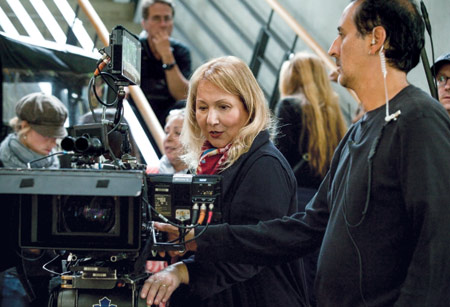
VERSATILE: (above) For an episode of Almost Human, Leder moved effortlessly from effects-laden sci-fi police drama, to (below) nail-biting action, to wildly comic sex farce on a recent episode of Shameless.
Fifteen years after the sci-fi blockbuster Deep Impact, director Mimi Leder’s name is still synonymous with “action.” But what has placed her in demand as a director of episodic television is an equal facility for navigating emotional landscapes.
“Lots of directors have technical proficiency and can move the camera well,” says producer and writer John Wells, with whom Leder has worked for much of her career. “What distinguishes extraordinary talent is when someone can do that and also deliver the emotional complexity these shows require.”
Leder says it begins in prep, with rigorous attention to the material. “It’s understanding the essence of the script, intellectually and emotionally—what the theme is, what the characters want, what they’re trying to achieve in each scene. I read it over and over to figure it out, and then I come up with ideas about how to tell the story visually.”
A recent episode of Shameless directed by Leder, entitled “A Long Way From Home,” moved effortlessly from nail-biting action, to wildly comic sex farce, to a courtroom custody battle that turned quietly devastating.
“It’s really hard to pull off,” says Wells, the executive producer and occasional director of Shameless. “It requires tremendous subtlety to execute, along with great instincts about what is important and what is unimportant; what is text and what is subtext. And Mimi excels at that.”
In recent months, she has directed a remarkable array of television episodes, including a musical (Smash), a minimalist drama (Full Circle, for DirecTV), and an effects-laden sci-fi police drama (Almost Human) about human cops partnered with androids in a Blade Runner-like future, premiering this fall.
Leder’s apprenticeship began at an early age, in a very different world, thanks to her father, Paul Leder, who directed dozens of low-budget feature films. He often prepped them at the family home in Los Angeles, so she and her siblings, Reuben (a screenwriter) and Geraldine (a casting director), grew up surrounded by film crews. “We would wake up to find people sleeping everywhere—on the couch, on the floor,” says Leder. “My mother cooked for the crew, my father edited in his office on a Moviola, and we kids did every job imaginable on these B-movie slashers. As a result, we all grew up as filmmakers.”
The movies were exploitation fare with titles like I Dismember Mama (1972) and My Friends Need Killing (1976), but Leder nonetheless learned important lessons from her father, an outsider who had segued from selling real estate to making movies. “He taught me about respect for the people you work with,” says Leder, who is known for her calm, steady demeanor on set. “I’m not a yeller or a screamer. I don’t believe that’s the way to get the best work out of people. He taught me fearlessness, and to keep moving forward—if something doesn’t work, try it another way.”
Leder studied at Los Angeles City College and then, at age 21, became a graduate fellow at the American Film Institute Conservatory, where she was the first female cinematography graduate. “I was in love with the possibility of creating great imagery, and fascinated by how lighting affected emotion,” she says. “I learned the camera inside and out, and the power of what a lens could help create within the storytelling. While I was studying, I realized I wanted to be a director.” After graduating in 1973, she worked in television as a script supervisor and then in 1985 made a short film that she showed to her bosses at Hill Street Blues, Stephen Bochco and Greg Hoblit. On the strength of that, they offered her a directing shot, but both men left the show before they could make it happen. When they had established themselves at their next show, L.A. Law, they were able to re-extend the offer in 1987—just a few weeks after Leder had just given birth to a daughter. She didn’t let that circumstance hold her back. “My breasts would engorge and I had ice packs on them and my arms folded over them, trying to direct,” she says. “It was hilarious.”
When she went on to direct an episode of the gritty Vietnam War drama China Beach in 1988, her career in episodic television began to take off. Director and series co-creator John Sacret Young asked her to become the show’s producer-director, which was then a new concept. The pilot had been directed by Rod Holcomb and Leder’s job was to maintain the tone by directing as many subsequent episodes as she could, while also hiring and prepping other directors. Her direction earned two Emmy nominations, while the show itself was nominated twice for best drama series.
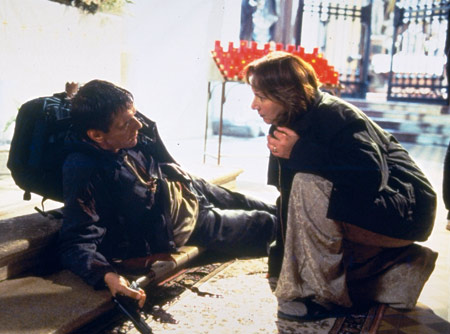
THEN AND NOW: (above) Leder directing the big-budget action film, The Peacemaker, the first release from DreamWorks. (below) She tapped her talent for action and emotion for the season finale of the HBO horse racing series Luck.
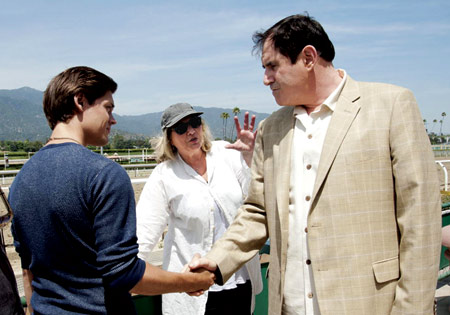
After China Beach ended its four-year run, various members of its creative team went on to develop the landmark medical drama ER. Wells, a writer and co-executive producer on China Beach, became the showrunner. Holcomb again directed the pilot, while Leder directed the next episode and many others. Also a producer on the series, she contributed greatly to the adrenaline-charged shooting style, in which a constantly moving camera follows emergency patients as they’re rushed down corridors. “Rod Holcomb set the tone in the pilot, and I enhanced that; if he used 25 percent Steadicam, I used 75 percent,” says Leder. “It became the signature of the show. We would do these six-page one-ers [covering six script pages in a single take] that combined many different moments—it took hours to set up. But if you accomplished one take before lunch, you had six pages done already. There was always so much pressure on the actor who had the last line not to fuck it up,” she laughs.
Scripts for the hour-long show often came in at 75 or 85 pages—a situation that Wells says demanded innovation from directors. Leder’s moving camera was her solution. “We had to cover a page in 30 seconds on that show, it moved at such a clip,” he says. “The style she developed was really central to what we were doing.”
“The hospital was an adrenaline-filled environment, and the Steadicam felt like a natural companion to that,” explains Leder. “I’m known for my fluid camera, but my goal is always for the camera movement to be organic; to have it work in concert with the performances and the story I’m telling so that it’s seamless—you don’t see it, you feel it.”
That attention to the nuances of storytelling has served Leder well. She received three DGA Award nominations for her work on ER, and in 1994 won an Emmy for directing (the last woman to do so for a dramatic series) for the episode “Love’s Labor Lost.” And with her fellow producers, she also won an Emmy that year for outstanding drama series.
Her ability to blend frenetic action with emotional intensity caught the attention of Steven Spielberg, a producer on ER via his Amblin Entertainment. In 1997 Spielberg tapped Leder to helm The Peacemaker, a $50 million action thriller slated to be the first release from DreamWorks. Even Leder was surprised, given that prevailing attitudes dictated that directing big-budget action was male territory. She says Spielberg told her, “You’re directing action on ER everyday.”
The film, about terrorists who steal nuclear warheads, presented significant hurdles: It would shoot entirely in Eastern Europe and New York City with an international crew, many of whom didn’t speak English, and a rushed preproduction period. On top of that, Leder’s father was dying. Rising to the challenge of such an ambitious first feature, Leder decided, would be the best possible tribute to what he had taught her. She felt his influence throughout the shoot, including one day when she needed a Shotmaker camera car, but none were available in Macedonia. “So we jerry-rigged an arm onto a pickup truck. We were following, and we came right around into the window of the car for a close-up of the guy driving. It was dangerous to do it that way but it was a nice shot. It was what my father had taught me—to just find a solution.”
Even before The Peacemaker was released, Spielberg hired Leder again for an even bigger feature, the $75 million, special effects-laden sci-fi disaster film Deep Impact. The film, about a race to head off human extinction as two meteors hurtle toward the Earth, captures Spielberg’s populist style (he had originally been slated to direct), while pulling off mega-scale visual effects, such as tidal waves engulfing Manhattan skyscrapers. It scored the second-biggest opening weekend of 1998, and made $350 million worldwide. “Not very many men make $350 million pictures,” Leder said at the time in Variety. “So it’s not about being a good woman director. I want to be recognized as a good director, period.”
Pay It Forward (2000), her next feature, was more down to earth, about a working-class kid who takes on a social studies assignment to change the world for the better. Leder drew standout performances from leads Kevin Spacey, Helen Hunt and Haley Joel Osment, with challenging, often gut-wrenching material. Her approach to working with actors, she says, involves discussion but little rehearsal. “We figure out what the scene is about, what we want from it, and how we’re going to get it,” she says. “But I don’t like to set a performance in a rehearsal; I like to capture it on film. That’s when the magic happens.”
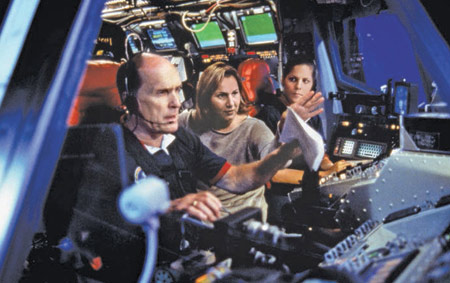
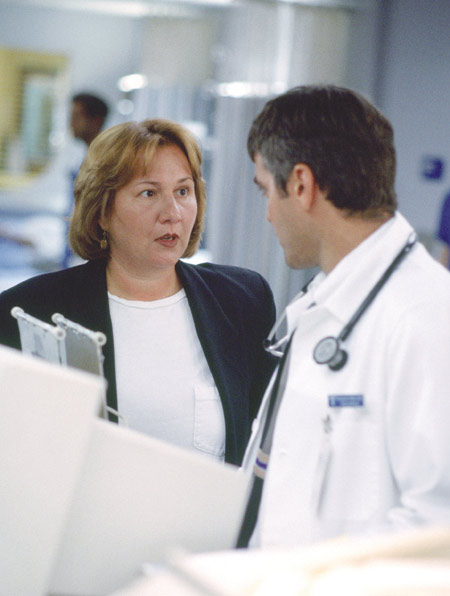

BIG MOMENTS: (top to bottom) The feature Deep Impact called for mega special effects; Leder helped develop the adrenaline-charged look of ER using a Steadicam; Pay it Forward deftly handled often gut-wrenching material on the big screen.
Early in her training, she took a directing workshop led by Method acting guru Lee Strasberg, which she says, “gave me a foundation for understanding the actor’s process. But they all speak a different language, and it can be a real chess game figuring out how to get the best out of each of them. Some require very little direction, and some require quite a bit. Casting is everything, and creating a safe environment to work in is everything.”
Pay It Forward drew some admiring reviews, but when it underperformed at the box office, Leder found that A-list movie scripts stopped arriving. “I was in movie jail,” she has said, noting, as have others, that this penalty box seems to disproportionally affect female directors. “It was painful climbing back from that.”
Opportunities in television were still there, and Leder focused increasingly on directing pilots, such as Vanished, a conspiracy thriller series on which she was also an executive producer. Since then, Leder has been seduced by the wave of cable and online networks that are remaking the rules of content. “Television has gotten so great in the last few years that I felt a real desire to jump back into directing episodic,” she says.
In particular, she prized the opportunity to direct the season one finale of HBO’s lavishly budgeted horse racing drama Luck, working alongside producers Michael Mann and David Milch, and star Dustin Hoffman. “It was like making a little movie,” says Leder of the episode, which ran for 67 commercial-free minutes. Because the episode’s centerpiece is the climactic Western Derby horse race, the network allowed for 10 days of prep (compared to the typical week) and 19 shooting days. “I used up every second,” she reports, turning the climactic neck-and-neck race into a six-minute pulse pounding, turf-churning show of power and beauty. Leder describes how this was achieved: “For every three furlongs [three-eighths of a mile] we were only allowed two takes, and in between, the horses would have to rest for 20 minutes.” To capture the sequence’s remarkably fresh angles, she says, “I had 12 cameras, and eight of them were operated. We had two camera trucks following the pack with poles hanging out, and guys hanging out of windows, grabbing the shots. I pretty much got the shots I wanted on the first run, but if the horses didn’t do what the story design required, we had to switch out horses and do it again. It was very, very exciting to be in a camera truck a few feet away watching those horses do what they were born to do—run. It was pure exhilaration.”
But Leder placed equal importance on a quieter interlude that she improvised in which ex-con mob boss Ace Bernstein (Hoffman), visits the stables just before the race, and is undone when he encounters strips of white rags fluttering in the breeze. Stealing a private moment, he fights back emotions that have been welling inside him. “As soon as I got to the track and saw these rags hanging, I knew I wanted to use them,” says Leder. “They’re used for binding the legs of these powerful horses, to give them extra strength. I thought the imagery was perfect for revealing a private man who never shares his true feelings with others.”
Leder framed Hoffman from low and behind as he beholds the wispy rags, then shot him from within the forest of white strips to partially reveal his face as he lets his emotions rise. “His life is closing in on him, someone has just tried to kill him, and yet, he regards these horses with deep love and awe,” says Leder. “There’s so much at stake for him. I wanted to create a moment where we got to glimpse that before the big race.”
In a complete contrast to the lavish scale of Luck, Leder recently directed two episodes of Full Circle, a rare TV venture from playwright-provocateur Neil LaBute. Funded at a bare-bones level by DirecTV, it involves 11 characters whose lives are unknowingly intertwined in the style of La Ronde. The half-hour episodes involve two characters conversing in a restaurant, followed by a subsequent episode concerning one of those characters and one new character. Each 24-page script was shot in a single day, except for the finale, directed by Leder, which involved all 11 characters and a two-day shoot.
“I rehearsed with the actors and approached it like a play, where everybody had to leave everything on the table,” says Leder, noting that the challenging material was guaranteed to offend everyone. “I had three cameras and we’d go for 15 or 20 pages, then change the angles and the lighting and do it again. It was a very raw way to direct.”
As busy as she is, and for all her enthusiasm about the renewed creative vitality of the small screen, Leder remains greatly interested in features. “I’d be very happy to direct another big-budget tentpole,” she says, “but the pickings are slim. It takes the executives and studio heads to push that button, and the tentpoles tend to go to men.”
In June, Leder was elected to the DGA’s National Board where she says she will continue to fight for more diversity in hiring. “I’ve been trying to change the face of episodic television for years by hiring women and people of color when I produce and direct,” she says. “The more you get to do something, the better you are at doing it. We have to stand up, keep letting them know we’re here, and make equality a reality.”
As a Board member, her priorities will include pushing for greater recognition for the episodic director. “It’s not just a writers’ medium,” she notes. “The director is the conduit between the script, the camera and the actors, the bridge that makes the material come alive. We bring a huge set of diverse skills to the party.”
Acknowledging those who have paved the way for her and also looking ahead, Leder says, “It’s such an honor to be able to work and tell stories. I feel like I’m living through such a great time, and hopefully I’m making a contribution.”